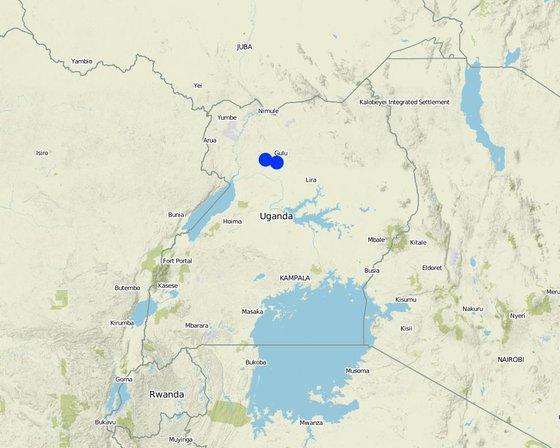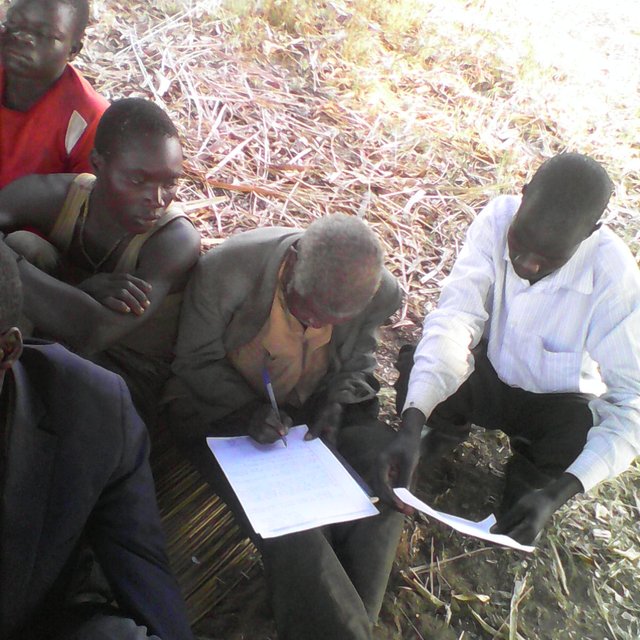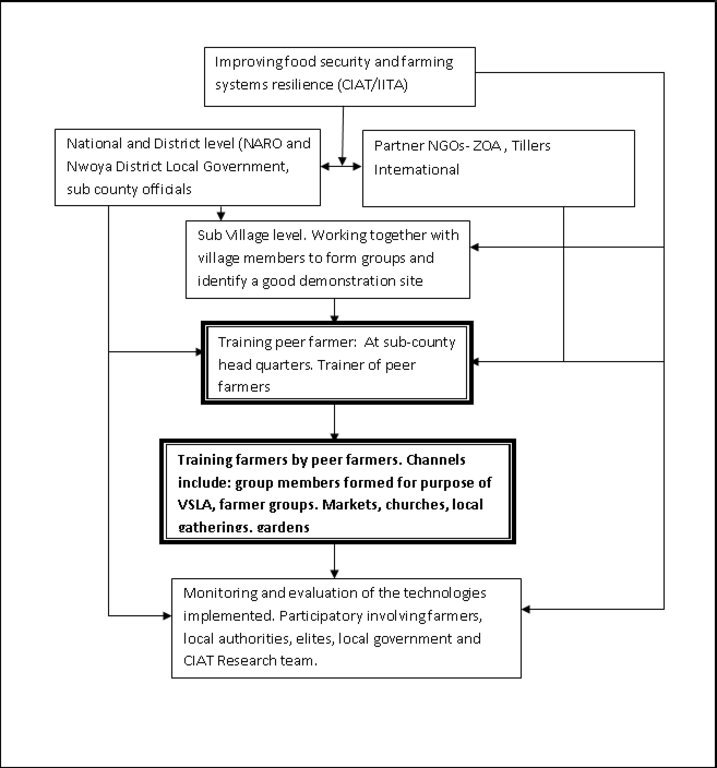Peer farmers as a village resource person for scaling Climate-Smart Agriculture (CSA) Practices
(Uganda)
Lawang Lupur (Rwot Kweri)
Description
A prosocial behavior approach, where a peer farmer identified by other local farmers is trained on a technology and then used as a trainer for the fellow farmers (farmer group or neighbors).
Adoption of sustainable agricultural practices requires an in-depth understanding of the implementation, sustainability and the opportunity cost involved. Empowered local resource persons known as peer farmers are used by the International Center for Tropical Agriculture (CIAT) and International Institute of Tropical Agriculture (IITA) in Northern Uganda as channels to ensure that farmers understand the importance and implementation of Climate Smart Agricultural (CSA) Practices such as using conservation farming (CF) permanent basins.
A peer farmer in this case is a local community member whom the farmers identify as a potential trainer, very cooperative and, if trained would be willing to share the knowledge with other farmers in that community. After training the peer farmers, an incentive is promised to them based on their performance over time. This incentive is a commodity that is very cheap, but valuable, and not usually a farm input. In this case weighing scale was used as an incentive.
The peer farmer then uses all available methods and channels to pass on to the knowledge to other folks. The acquired knowledge and skills are usually shared through community meetings, religious gatherings, market places and so on.
The process of implementing this approach includes: Identifying the place of implementation, working with the farmers to identify a potential peer farmer, training the peer farmer, the peer farmer training other farmers over time and monitoring the progress of knowledge spill over. Stakeholders involved: Field staff - Work with farmers to identify and train peers, monitor activities; local leaders - organize community members; peer farmer - attend training, train other farmers.
This method is cheap, farmers identify someone with fairly good pro-social behavior, and farmers would be willing to learn from their own village member.
Location

Location: Alero Sub-county, Nwoya District, Uganda
Geo-reference of selected sites
-
31.99964, 2.63475
-
32.00125, 2.63325
-
32.22205, 2.58247
-
32.22202, 2.58249
Initiation date: 2015
Year of termination: n.a.
Type of Approach
-
traditional/ indigenous
-
recent local initiative/ innovative
-
project/ programme based

a peer farmer showing practices (Amale Balla Sunday)
Approach aims and enabling environment
Main aims / objectives of the approach
Promoting adoption of Climate-Smart Agriculture through prosocial behaviour
Conditions enabling the implementation of the Technology/ ies applied under the Approach
-
Social/ cultural/ religious norms and values: traditional relations among local communities
-
Institutional setting: Agricultural Advisory services in the country, more NGOs operating in the agricultural sector
-
Collaboration/ coordination of actors: Participatory involvement of all the stakeholders in the agricultural sector
-
Policies: PMA-Plan for Modernisation of Agriculture, a Government policy aimed at ensuring adoption of modern farming technologies.
Policy Action on climate change adaptation
Vision 2040 - A government policy aims at transforming Uganda's agriculture from subsistence to commercial farming.
-
Knowledge about SLM, access to technical support: Trainings from different agencies
-
Markets (to purchase inputs, sell products) and prices: high demands for food produce and favorable market prices with good roads
-
Workload, availability of manpower: use local people at their own times
Conditions hindering the implementation of the Technology/ ies applied under the Approach
-
Social/ cultural/ religious norms and values: limited cooperation among some communities
-
Knowledge about SLM, access to technical support: costs to fund the training of peer farmers
-
Markets (to purchase inputs, sell products) and prices: middle men cheat poor farmers
-
Workload, availability of manpower: illiteracy
Participation and roles of stakeholders involved
Stakeholders involved in the Approach and their roles
| What stakeholders / implementing bodies were involved in the Approach? |
Specify stakeholders |
Describe roles of stakeholders |
| local land users/ local communities |
farmers and local leaders |
implement the technology |
| community-based organizations |
farmer groups |
used as a channel |
| SLM specialists/ agricultural advisers |
extension workers |
train on the SLM technologies |
| researchers |
CIAT/IITA |
Assess the degree of resilience |
| international organization |
CIAT/IITA |
funding research activities |
Lead agency
CIAT
Involvement of local land users/ local communities in the different phases of the Approach
none
passive
external support
interactive
self-mobilization
initiation/ motivation
CIAT project promoting food security and farming systems resilience in East Africa through wide-scale adoption of climate smart agriculture. The project is implemented in Nwoya district, designed by CIAT and funded by IFAD.
planning
CIAT/IITA: IITA became partner organisation for the project. Staffing was done through IITA, implemented in collaboration with IITA Uganda.
implementation
CIAT, IITA, Local government, National Agricultural Research Organisation, ZOA, Farmers, Extension agents
monitoring/ evaluation
Participatory monitoring and evaluation involving all parties through farmers field days
Flow chart
detailed chart showing the different planyers in the approach

Author: Amale Balla Sunday
Decision-making on the selection of SLM Technology
Decisions were taken by
-
land users alone (self-initiative)
-
mainly land users, supported by SLM specialists
-
all relevant actors, as part of a participatory approach
-
mainly SLM specialists, following consultation with land users
-
SLM specialists alone
-
politicians/ leaders
Decisions were made based on
-
evaluation of well-documented SLM knowledge (evidence-based decision-making)
-
research findings
-
personal experience and opinions (undocumented)
Technical support, capacity building, and knowledge management
The following activities or services have been part of the approach
-
Capacity building/ training
-
Advisory service
-
Institution strengthening (organizational development)
-
Monitoring and evaluation
-
Research
Capacity building/ training
Training was provided to the following stakeholders
-
land users
-
field staff/ advisers
Form of training
-
on-the-job
-
farmer-to-farmer
-
demonstration areas
-
public meetings
-
courses
Advisory service
Advisory service was provided
-
on land users' fields
-
at permanent centres
planned visits to peer farmers fields to observe what they are doing and advising them accordingly.
Institution strengthening
Institutions have been strengthened / established
-
no
-
yes, a little
-
yes, moderately
-
yes, greatly
Describe institution, roles and responsibilities, members, etc.
local farmer groups
Type of support
-
financial
-
capacity building/ training
-
equipment
Further details
Monitoring and evaluation
Research
Research treated the following topics
-
sociology
-
economics / marketing
-
ecology
-
technology
CIAT/IITA Research in Northern Uganda under the project; Promoting food security and farming systems resilience in East Africa through wide scale adoption of climate smart Agriculture (CSA)
Financing and external material support
Annual budget in USD for the SLM component
-
< 2,000
-
2,000-10,000
-
10,000-100,000
-
100,000-1,000,000
-
> 1,000,000
Precise annual budget: n.a.
The following services or incentives have been provided to land users
-
Financial/ material support provided to land users
-
Subsidies for specific inputs
-
Credit
-
Other incentives or instruments
Other incentives or instruments
weighing scale for best performers
Impact analysis and concluding statements
Impacts of the Approach
No
Yes, little
Yes, moderately
Yes, greatly
Did the Approach empower local land users, improve stakeholder participation?
yes, improved group work
Did the Approach enable evidence-based decision-making?
decision made by community members
Did the Approach help land users to implement and maintain SLM Technologies?
incentive driven
Did the Approach improve coordination and cost-effective implementation of SLM?
farmers working with each other
Did the Approach mobilize/ improve access to financial resources for SLM implementation?
promoted group work but directed towards technology transfer
Did the Approach improve knowledge and capacities of land users to implement SLM?
new technologies
Did the Approach improve knowledge and capacities of other stakeholders?
mostly farmers involved
Did the Approach build/ strengthen institutions, collaboration between stakeholders?
different stakeholders participated
Did the Approach mitigate conflicts?
improved social relations
Did the Approach empower socially and economically disadvantaged groups?
did not focus on well off farmers, just anyone whom the community thinks has the potential to train local members
Did the Approach improve gender equality and empower women and girls?
50% of trainers were women and at the end they performed better than the men trainers
Did the Approach encourage young people/ the next generation of land users to engage in SLM?
ensure transfer to local people
Did the Approach improve issues of land tenure/ user rights that hindered implementation of SLM Technologies?
Did the Approach lead to improved food security/ improved nutrition?
much higher increase in production
Did the Approach improve access to markets?
good quality products
Did the Approach lead to improved access to water and sanitation?
farm based
Did the Approach lead to more sustainable use/ sources of energy?
farm based
Did the Approach improve the capacity of the land users to adapt to climate changes/ extremes and mitigate climate related disasters?
Did the Approach lead to employment, income opportunities?
to trainers of peer farmers
Main motivation of land users to implement SLM
-
increased production
-
increased profit(ability), improved cost-benefit-ratio
-
reduced land degradation
-
reduced risk of disasters
-
reduced workload
-
payments/ subsidies
-
rules and regulations (fines)/ enforcement
-
prestige, social pressure/ social cohesion
-
affiliation to movement/ project/ group/ networks
-
environmental consciousness
-
customs and beliefs, morals
-
enhanced SLM knowledge and skills
-
aesthetic improvement
-
conflict mitigation
Sustainability of Approach activities
Can the land users sustain what hat been implemented through the Approach (without external support)?
The knowledge becomes local to the farmers; observes direct benefits whitin the shortest time of implementation, learn other things from neighbors without need for any motivation
Conclusions and lessons learnt
Strengths: land user's view
-
farmers can easily learn from each other
-
peer trains farmers within their local environment
Strengths: compiler’s or other key resource person’s view
-
All available methods of passing information about the technologies are at the peer farmers disposal eg. market points, church, group meetings, tribal gatherings
-
farmers use their local language to teach/demonstrate to each other
Weaknesses/ disadvantages/ risks: land user's viewhow to overcome
-
difficult to train peer farmers
use practicals
-
peer farmers may not retain all the knowledge about the technology
use charts/pictures
Weaknesses/ disadvantages/ risks: compiler’s or other key resource person’s viewhow to overcome
-
costly to organise trainings for peers
use local education facilities such as schools for training peer farmers
References
Editors
-
JOY TUKAHIRWA
-
Kamugisha Rick Nelson
Reviewer
-
John Stephen Tenywa
-
Nicole Harari
Date of documentation: Des. 18, 2017
Last update: Okt. 18, 2018
Resource persons
-
Kilama Odong - land user
-
Micheal Sunday - None
Full description in the WOCAT database
Documentation was faciliated by
Institution
- Uganda Landcare Network (ULN) - Uganda
Project
- Scaling-up SLM practices by smallholder farmers (IFAD)






